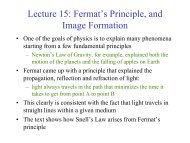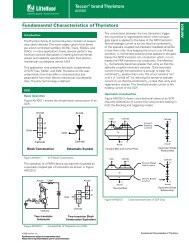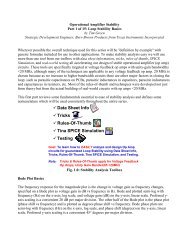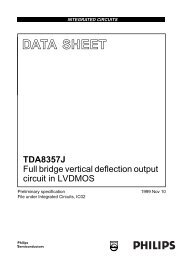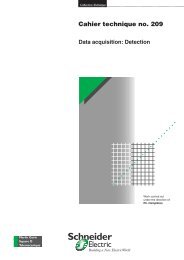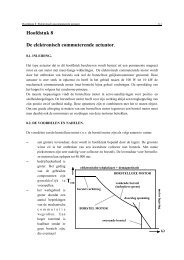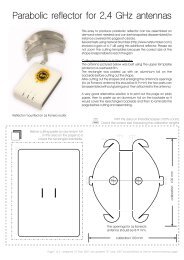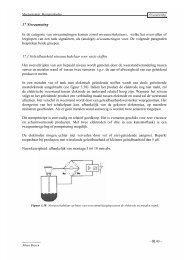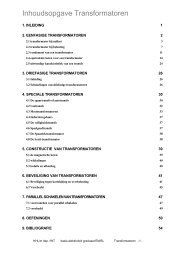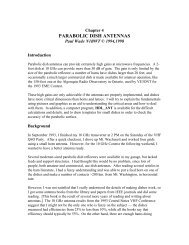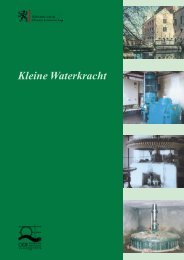Open Channel Hydraulics - EFM - iETSI - School of Mechanical ...
Open Channel Hydraulics - EFM - iETSI - School of Mechanical ...
Open Channel Hydraulics - EFM - iETSI - School of Mechanical ...
You also want an ePaper? Increase the reach of your titles
YUMPU automatically turns print PDFs into web optimized ePapers that Google loves.
CIVE2400 Fluid Mechanics<br />
Section 2: <strong>Open</strong> <strong>Channel</strong> <strong>Hydraulics</strong><br />
1. <strong>Open</strong> <strong>Channel</strong> <strong>Hydraulics</strong> ................................................................................................... 2<br />
1.1 Definition and differences between pipe flow and open channel flow............................... 2<br />
1.2 Types <strong>of</strong> flow ...................................................................................................................... 3<br />
1.3 Properties <strong>of</strong> open channels ............................................................................................... 4<br />
1.4 Fundamental equations........................................................................................................ 5<br />
1.4.1 The Continuity Equation (conservation <strong>of</strong> mass)............................................................ 6<br />
1.4.2 The Energy equation (conservation <strong>of</strong> energy)............................................................... 7<br />
1.4.3 The momentum equation (momentum principle) ........................................................... 8<br />
1.5 Velocity distribution in open channels................................................................................ 9<br />
1.5.1 Determination <strong>of</strong> energy and momentum coefficients.................................................. 10<br />
1.6 Laminar and Turbulent flow ............................................................................................. 11<br />
1.7 Uniform flow and the Development <strong>of</strong> Friction formulae................................................ 12<br />
1.7.1 The Chezy equation....................................................................................................... 13<br />
1.7.2 The Manning equation .................................................................................................. 13<br />
1.7.3 Conveyance................................................................................................................... 14<br />
1.8 Computations in uniform flow.......................................................................................... 15<br />
1.8.1 Uniform flow example 1 - Discharge from depth in a trapezoidal channel.................. 15<br />
1.8.2 Uniform flow example 2 - Depth from Discharge in a trapezoidal channel................. 16<br />
1.8.3 Uniform flow example 3 - A compound channel.......................................................... 17<br />
1.9 The Application <strong>of</strong> the Energy equation for Rapidly Varied Flow................................... 18<br />
1.9.1 The energy (Bernoulli) equation ................................................................................... 19<br />
1.9.2 Flow over a raised hump - Application <strong>of</strong> the Bernoulli equation................................ 20<br />
1.9.3 Specific Energy ............................................................................................................. 21<br />
1.9.4 Flow over a raised hump - revisited. Application <strong>of</strong> the Specific energy equation...... 22<br />
1.9.5 Example <strong>of</strong> the raised bed hump................................................................................... 22<br />
1.10 Critical , Sub-critical and super critical flow .................................................................... 23<br />
1.11 The Froude number........................................................................................................... 25<br />
1.12 Application <strong>of</strong> the Momentum equation for Rapidly Varied Flow................................... 26<br />
1.13 Gradually varied flow ....................................................................................................... 27<br />
1.13.1 Example <strong>of</strong> critical slope calculation ............................................................................ 28<br />
1.13.2 Transitions between sub and super critical flow........................................................... 28<br />
1.14 The equations <strong>of</strong> gradually varied flow ............................................................................ 29<br />
1.15 Classification <strong>of</strong> pr<strong>of</strong>iles ................................................................................................... 30<br />
1.16 How to determine the surface pr<strong>of</strong>iles .............................................................................. 34<br />
1.17 Method <strong>of</strong> solution <strong>of</strong> the Gradually varied flow equation............................................... 35<br />
1.17.1 Numerical methods ....................................................................................................... 35<br />
1.17.2 The direct step method – distance from depth .............................................................. 35<br />
1.17.3 The standard step method – depth from distance.......................................................... 36<br />
1.17.4 The Standard step method – alternative form ............................................................... 36<br />
1.18 Structures........................................................................................................................... 36<br />
1.19 Critical depth meters ......................................................................................................... 36<br />
1.19.1 Broad-crested weir ........................................................................................................ 37<br />
1.19.2 Flumes........................................................................................................................... 38<br />
1.19.3 Venturi flume ................................................................................................................ 38<br />
CIVE 2400: Fluid Mechanics <strong>Open</strong> <strong>Channel</strong> <strong>Hydraulics</strong><br />
1
1. <strong>Open</strong> <strong>Channel</strong> <strong>Hydraulics</strong><br />
1.1 Definition and differences between pipe flow and open channel flow<br />
The flow <strong>of</strong> water in a conduit may be either open channel flow or pipe flow. The two kinds <strong>of</strong><br />
flow are similar in many ways but differ in one important respect. <strong>Open</strong>-channel flow must have<br />
a free surface, whereas pipe flow has none. A free surface is subject to atmospheric pressure. In<br />
Pipe flow there exist no direct atmospheric flow but hydraulic pressure only.<br />
Energy line<br />
Hydraulic<br />
gradient<br />
Centre line<br />
1 2<br />
hf<br />
2 v /2g<br />
y<br />
z<br />
Energy line<br />
Water<br />
surface<br />
<strong>Channel</strong> bed<br />
Figure <strong>of</strong> pipe and open channel flow<br />
1<br />
2<br />
hf<br />
2<br />
v /2g<br />
The two kinds <strong>of</strong> flow are compared in the figure above. On the left is pipe flow. Two<br />
piezometers are placed in the pipe at sections 1 and 2. The water levels in the pipes are<br />
maintained by the pressure in the pipe at elevations represented by the hydraulics grade line or<br />
hydraulic gradient. The pressure exerted by the water in each section <strong>of</strong> the pipe is shown in the<br />
tube by the height y <strong>of</strong> a column <strong>of</strong> water above the centre line <strong>of</strong> the pipe.<br />
The total energy <strong>of</strong> the flow <strong>of</strong> the section (with reference to a datum) is the sum <strong>of</strong> the elevation<br />
z <strong>of</strong> the pipe centre line, the piezometric head y and the velocity head V 2 /2g , where V is the<br />
mean velocity. The energy is represented in the figure by what is known as the energy grade line<br />
or the energy gradient.<br />
The loss <strong>of</strong> energy that results when water flows from section 1 to section 2 is represented by hf.<br />
A similar diagram for open channel flow is shown to the right. This is simplified by assuming<br />
parallel flow with a uniform velocity distribution and that the slope <strong>of</strong> the channel is small. In<br />
this case the hydraulic gradient is the water surface as the depth <strong>of</strong> water corresponds to the<br />
piezometric height.<br />
Despite the similarity between the two kinds <strong>of</strong> flow, it is much more difficult to solve problems<br />
<strong>of</strong> flow in open channels than in pipes. Flow conditions in open channels are complicated by the<br />
position <strong>of</strong> the free surface which will change with time and space. And also by the fact that<br />
depth <strong>of</strong> flow, the discharge, and the slopes <strong>of</strong> the channel bottom and <strong>of</strong> the free surface are all<br />
inter dependent.<br />
Physical conditions in open-channels vary much more than in pipes – the cross-section <strong>of</strong> pipes<br />
is usually round – but for open channel it can be any shape.<br />
Treatment <strong>of</strong> roughness also poses a greater problem in open channels than in pipes. Although<br />
there may be a great range <strong>of</strong> roughness in a pipe from polished metal to highly corroded iron,<br />
CIVE 2400: Fluid Mechanics <strong>Open</strong> <strong>Channel</strong> <strong>Hydraulics</strong><br />
y<br />
z<br />
2
open channels may be <strong>of</strong> polished metal to natural channels with long grass and roughness that<br />
may also depend on depth <strong>of</strong> flow.<br />
<strong>Open</strong> channel flows are found in large and small scale. For example the flow depth can vary<br />
between a few cm in water treatment plants and over 10m in large rivers. The mean velocity <strong>of</strong><br />
flow may range from less than 0.01 m/s in tranquil waters to above 50 m/s in high-head<br />
spillways. The range <strong>of</strong> total discharges may extend from 0.001 l/s in chemical plants to greater<br />
than 10000 m 3 /s in large rivers or spillways.<br />
In each case the flow situation is characterised by the fact that there is a free surface whose<br />
position is NOT known beforehand – it is determined by applying momentum and continuity<br />
principles.<br />
<strong>Open</strong> channel flow is driven by gravity rather than by pressure work as in pipes.<br />
Pipe flow <strong>Open</strong> <strong>Channel</strong> flow<br />
Flow driven by Pressure work Gravity (potential energy)<br />
Flow cross section Known, fixed Unknown in advance<br />
because the flow depth is<br />
Characteristics flow<br />
parameters<br />
Specific boundary<br />
conditions<br />
1.2 Types <strong>of</strong> flow<br />
velocity deduced from<br />
continuity<br />
unknown<br />
Flow depth deduced<br />
simultaneously from<br />
solving both continuity<br />
and momentum equations<br />
Atmospheric pressure at<br />
the free surface<br />
The following classifications are made according to change in flow depth with respect to time<br />
and space.<br />
RVF<br />
RVF GVF RVF GVF RVF GVF RVF GVF<br />
Figure <strong>of</strong> the types <strong>of</strong> flow that may occur in open channels<br />
CIVE 2400: Fluid Mechanics <strong>Open</strong> <strong>Channel</strong> <strong>Hydraulics</strong><br />
3
Steady and Unsteady: Time is the criterion.<br />
Flow is said to be steady if the depth <strong>of</strong> flow at a particular point does not change or can be<br />
considered constant for the time interval under consideration. The flow is unsteady if depth<br />
changes with time.<br />
Uniform Flow: Space as the criterion.<br />
<strong>Open</strong> <strong>Channel</strong> flow is said to be uniform if the depth and velocity <strong>of</strong> flow are the same at every<br />
section <strong>of</strong> the channel. Hence it follows that uniform flow can only occur in prismatic channels.<br />
For steady uniform flow, depth and velocity is constant with both time and distance. This<br />
constitutes the fundamental type <strong>of</strong> flow in an open channel. It occurs when gravity forces are in<br />
equilibrium with resistance forces.<br />
Steady non-uniform flow.<br />
Depth varies with distance but not with time. This type <strong>of</strong> flow may be either (a) gradually<br />
varied or (b) rapidly varied. Type (a) requires the application <strong>of</strong> the energy and frictional<br />
resistance equations while type (b) requires the energy and momentum equations.<br />
Unsteady flow<br />
The depth varies with both time and space. This is the most common type <strong>of</strong> flow and requires<br />
the solution <strong>of</strong> the energy momentum and friction equations with time. In many practical cases<br />
the flow is sufficiently close to steady flow therefore it can be analysed as gradually varied<br />
steady flow.<br />
1.3 Properties <strong>of</strong> open channels<br />
Artificial channels<br />
These are channels made by man. They include irrigation canals, navigation canals, spillways,<br />
sewers, culverts and drainage ditches. They are usually constructed in a regular cross-section<br />
shape throughout – and are thus prismatic channels (they don’t widen or get narrower along the<br />
channel. In the field they are commonly constructed <strong>of</strong> concrete, steel or earth and have the<br />
surface roughness’ reasonably well defined (although this may change with age – particularly<br />
grass lined channels.) Analysis <strong>of</strong> flow in such well defined channels will give reasonably<br />
accurate results.<br />
Natural channels<br />
Natural channels can be very different. They are not regular nor prismatic and their materials <strong>of</strong><br />
construction can vary widely (although they are mainly <strong>of</strong> earth this can possess many different<br />
properties.) The surface roughness will <strong>of</strong>ten change with time distance and even elevation.<br />
Consequently it becomes more difficult to accurately analyse and obtain satisfactory results for<br />
natural channels than is does for man made ones. The situation may be further complicated if the<br />
boundary is not fixed i.e. erosion and deposition <strong>of</strong> sediments.<br />
Geometric properties necessary for analysis<br />
For analysis various geometric properties <strong>of</strong> the channel cross-sections are required. For artificial<br />
channels these can usually be defined using simple algebraic equations given y the depth <strong>of</strong> flow.<br />
The commonly needed geometric properties are shown in the figure below<br />
and defined as:<br />
CIVE 2400: Fluid Mechanics <strong>Open</strong> <strong>Channel</strong> <strong>Hydraulics</strong><br />
4
Depth (y) – the vertical distance from the lowest point <strong>of</strong> the channel section to the free surface.<br />
Stage (z) – the vertical distance from the free surface to an arbitrary datum<br />
Area (A) – the cross-sectional area <strong>of</strong> flow, normal to the direction <strong>of</strong> flow<br />
Wetted perimeter (P) – the length <strong>of</strong> the wetted surface measured normal to the direction <strong>of</strong><br />
flow.<br />
Surface width (B) – width <strong>of</strong> the channel section at the free surface<br />
Hydraulic radius (R) – the ratio <strong>of</strong> area to wetted perimeter (A/P)<br />
Hydraulic mean depth (Dm) – the ratio <strong>of</strong> area to surface width (A/B)<br />
Rectangle Trapezoid Circle<br />
B<br />
B<br />
b<br />
y<br />
Area, A by (b+xy)y ( ) 2<br />
1 x<br />
b<br />
y<br />
D<br />
8<br />
φ<br />
1 φ − sinφ D<br />
Wetted perimeter P b + 2y<br />
b + 2y 2<br />
1+<br />
x<br />
1<br />
2 φD<br />
Top width B b b+2xy ( sinφ 2)D<br />
Hydraulic radius R<br />
Hydraulic mean<br />
depth Dm<br />
by ( b + 2y<br />
)<br />
y<br />
( b + xy)<br />
y<br />
2<br />
b + 2y 1+<br />
x<br />
( b + xy)<br />
y<br />
b + 2xy<br />
1 ⎛ sinφ<br />
⎞<br />
⎜1−<br />
⎟D<br />
4 ⎝ φ ⎠<br />
1 ⎛ φ − sinφ<br />
⎞<br />
⎜ ⎟<br />
8 ⎝ sin 1/<br />
2φ<br />
⎠<br />
( ) D<br />
Table <strong>of</strong> equations for rectangular trapezoidal and circular channels.<br />
1.4 Fundamental equations<br />
The equations which describe the flow <strong>of</strong> fluid are derived from three fundamental laws <strong>of</strong><br />
physics:<br />
1. Conservation <strong>of</strong> matter (or mass)<br />
2. Conservation <strong>of</strong> energy<br />
3. Conservation <strong>of</strong> momentum<br />
Although first developed for solid bodies they are equally applicable to fluids. A brief<br />
description <strong>of</strong> the concepts are given below.<br />
Conservation <strong>of</strong> matter<br />
This says that matter can not be created nor destroyed, but it may be converted (e.g. by a<br />
chemical process.) In fluid mechanics we do not consider chemical activity so the law reduces to<br />
one <strong>of</strong> conservation <strong>of</strong> mass.<br />
Conservation <strong>of</strong> energy<br />
This says that energy can not be created nor destroyed, but may be converted form one type to<br />
another (e.g. potential may be converted to kinetic energy). When engineers talk about energy<br />
"losses" they are referring to energy converted from mechanical (potential or kinetic) to some<br />
other form such as heat. A friction loss, for example, is a conversion <strong>of</strong> mechanical energy to<br />
heat. The basic equations can be obtained from the First Law <strong>of</strong> Thermodynamics but a<br />
simplified derivation will be given below.<br />
CIVE 2400: Fluid Mechanics <strong>Open</strong> <strong>Channel</strong> <strong>Hydraulics</strong><br />
d<br />
5
Conservation <strong>of</strong> momentum<br />
The law <strong>of</strong> conservation <strong>of</strong> momentum says that a moving body cannot gain or lose momentum<br />
unless acted upon by an external force. This is a statement <strong>of</strong> Newton's Second Law <strong>of</strong> Motion:<br />
Force = rate <strong>of</strong> change <strong>of</strong> momentum<br />
In solid mechanics these laws may be applied to an object which is has a fixed shape and is<br />
clearly defined. In fluid mechanics the object is not clearly defined and as it may change shape<br />
constantly. To get over this we use the idea <strong>of</strong> control volumes. These are imaginary volumes <strong>of</strong><br />
fluid within the body <strong>of</strong> the fluid. To derive the basic equation the above conservation laws are<br />
applied by considering the forces applied to the edges <strong>of</strong> a control volume within the fluid.<br />
1.4.1 The Continuity Equation (conservation <strong>of</strong> mass)<br />
For any control volume during the small time interval δt the principle <strong>of</strong> conservation <strong>of</strong> mass<br />
implies that the mass <strong>of</strong> flow entering the control volume minus the mass <strong>of</strong> flow leaving the<br />
control volume equals the change <strong>of</strong> mass within the control volume.<br />
If the flow is steady and the fluid incompressible the mass entering is equal to the mass leaving,<br />
so there is no change <strong>of</strong> mass within the control volume.<br />
So for the time interval δt:<br />
A1<br />
V1<br />
A2<br />
V2<br />
Mass flow entering = mass flow leaving<br />
z1<br />
Figure <strong>of</strong> a small length <strong>of</strong> channel as a control volume<br />
y1<br />
d1<br />
θ<br />
z2<br />
y2<br />
surface<br />
Considering the control volume above which is a short length <strong>of</strong> open channel <strong>of</strong> arbitrary crosssection<br />
then, if ρ is the fluid density and Q is the volume flow rate then<br />
mass flow rate is ρQ and the continuity equation for steady incompressible flow can be written<br />
ρ Q = ρQ<br />
entering<br />
As, Q, the volume flow rate is the product <strong>of</strong> the area and the mean velocity then at the upstream<br />
leaving<br />
face (face 1) where the mean velocity is u1 and the cross-sectional area is A1 then:<br />
Q = u<br />
entering 1 1<br />
Similarly at the downstream face, face 2, where mean velocity is u2 and the cross-sectional area<br />
is A2 then:<br />
CIVE 2400: Fluid Mechanics <strong>Open</strong> <strong>Channel</strong> <strong>Hydraulics</strong><br />
A<br />
bed<br />
6
Q = u<br />
leaving<br />
Therefore the continuity equation can be written as<br />
u A = u<br />
1.4.2 The Energy equation (conservation <strong>of</strong> energy)<br />
1<br />
1<br />
2<br />
2<br />
A<br />
A<br />
2<br />
2<br />
Equation 1.1<br />
Consider the forms <strong>of</strong> energy available for the above control volume. If the fluid moves from the<br />
upstream face 1, to the downstream face 2 in time δt over the length L.<br />
The work done in moving the fluid through face 1 during this time is<br />
where p1 is pressure at face 1<br />
The mass entering through face 1 is<br />
work done =<br />
Therefore the kinetic energy <strong>of</strong> the system is:<br />
p1 1<br />
mass entering = ρ<br />
1<br />
2<br />
1<br />
2<br />
2<br />
KE = mu = ρ1<br />
A L<br />
1A1<br />
1<br />
L<br />
A Lu<br />
If z1 is the height <strong>of</strong> the centroid <strong>of</strong> face 1, then the potential energy <strong>of</strong> the fluid entering the<br />
control volume is :<br />
PE = mgz = ρ A L g z<br />
The total energy entering the control volume is the sum <strong>of</strong> the work done, the potential and the<br />
kinetic energy:<br />
1<br />
2<br />
Total energy = p1 A1L<br />
+ ρ 1A1<br />
Lu1<br />
+ ρ1<br />
A1Lgz1<br />
2<br />
We can write this in terms <strong>of</strong> energy per unit weight. As the weight <strong>of</strong> water entering the control<br />
volume is ρ1 A1 L g then just divide by this to get the total energy per unit weight:<br />
2<br />
p1<br />
u1<br />
Total energy per unit weight<br />
= + + z1<br />
ρ g 2g<br />
At the exit to the control volume, face 2, similar considerations deduce<br />
2<br />
2 2<br />
Total energy per unit weight<br />
= + + z2<br />
ρ 2 g 2g<br />
If no energy is supplied to the control volume from between the inlet and the outlet then energy<br />
leaving = energy entering and if the fluid is incompressible ρ1 = ρ1 = ρ<br />
CIVE 2400: Fluid Mechanics <strong>Open</strong> <strong>Channel</strong> <strong>Hydraulics</strong><br />
1<br />
1<br />
1<br />
p<br />
1<br />
2<br />
1<br />
u<br />
7
So,<br />
This is the Bernoulli equation.<br />
2<br />
2<br />
p1<br />
u1<br />
p2<br />
u2<br />
+ + z1<br />
= + + z2<br />
= H = constant<br />
ρg<br />
2g<br />
ρg<br />
2g<br />
Equation 1.2<br />
Note:<br />
1. In the derivation <strong>of</strong> the Bernoulli equation it was assumed that no energy is lost in the control<br />
volume - i.e. the fluid is frictionless. To apply to non frictionless situations some energy loss<br />
term must be included<br />
2. The dimensions <strong>of</strong> each term in equation 1.2 has the dimensions <strong>of</strong> length ( units <strong>of</strong> meters).<br />
For this reason each term is <strong>of</strong>ten regarded as a "head" and given the names<br />
p<br />
ρg<br />
=<br />
2<br />
u<br />
=<br />
2g<br />
pressure head<br />
velocity head<br />
z = velocity or potential head<br />
3. Although above we derived the Bernoulli equation between two sections it should strictly<br />
speaking be applied along a stream line as the velocity will differ from the top to the bottom<br />
<strong>of</strong> the section. However in engineering practise it is possible to apply the Bernoulli equation<br />
with out reference to the particular streamline<br />
1.4.3 The momentum equation (momentum principle)<br />
Again consider the control volume above during the time δt<br />
momentum entering<br />
momentum leaving<br />
= ρδQ<br />
δtu<br />
2<br />
1<br />
= ρδQ<br />
δtu<br />
By the continuity principle : δQ1 = δQ2 = δQ<br />
And by Newton's second law Force = rate <strong>of</strong> change <strong>of</strong> momentum<br />
δF<br />
=<br />
=<br />
momentum leaving - momentum entering<br />
δt<br />
ρδQ<br />
( u − u )<br />
2<br />
1<br />
It is more convenient to write the force on a control volume in each <strong>of</strong> the three, x, y and z<br />
direction e.g. in the x-direction<br />
δ<br />
( u u )<br />
Fx = ρδQ<br />
2x − 1x<br />
CIVE 2400: Fluid Mechanics <strong>Open</strong> <strong>Channel</strong> <strong>Hydraulics</strong><br />
2<br />
1<br />
8
Integration over a volume gives the total force in the x-direction as<br />
( V V )<br />
Fx = ρ Q 2x − 1x<br />
As long as velocity V is uniform over the whole cross-section.<br />
This is the momentum equation for steady flow for a region <strong>of</strong> uniform velocity.<br />
Energy and Momentum coefficients<br />
Equation 1.3<br />
In deriving the above momentum and energy (Bernoulli) equations it was noted that the velocity<br />
must be constant (equal to V) over the whole cross-section or constant along a stream-line.<br />
Clearly this will not occur in practice. Fortunately both these equation may still be used even for<br />
situations <strong>of</strong> quite non-uniform velocity distribution over a section. This is possible by the<br />
introduction <strong>of</strong> coefficients <strong>of</strong> energy and momentum, α and β respectively.<br />
These are defined:<br />
where V is the mean velocity.<br />
3<br />
ρu<br />
dA<br />
α 3<br />
ρV<br />
A<br />
∫ =<br />
2<br />
∫ ρu<br />
dA<br />
β = 2<br />
ρV<br />
A<br />
And the Bernoulli equation can be rewritten in terms <strong>of</strong> this mean velocity:<br />
And the momentum equation becomes:<br />
2<br />
p αV<br />
+ + z = constant<br />
ρg<br />
2g<br />
( V V )<br />
Fx = ρ Qβ<br />
2x − 1x<br />
Equation 1.4<br />
Equation 1.5<br />
Equation 1.6<br />
Equation 1.7<br />
The values <strong>of</strong> α and β must be derived from the velocity distributions across a cross-section.<br />
They will always be greater than 1, but only by a small amount consequently they can <strong>of</strong>ten be<br />
confidently omitted – but not always and their existence should always be remembered. For<br />
turbulent flow in regular channel α does not usually go above 1.15 and β will normally be below<br />
1.05. We will see an example below where their inclusion is necessary to obtain accurate results.<br />
1.5 Velocity distribution in open channels<br />
The measured velocity in an open channel will always vary across the channel section because <strong>of</strong><br />
friction along the boundary. Neither is this velocity distribution usually axisymmetric (as it is in<br />
pipe flow) due to the existence <strong>of</strong> the free surface. It might be expected to find the maximum<br />
velocity at the free surface where the shear force is zero but this is not the case. The maximum<br />
CIVE 2400: Fluid Mechanics <strong>Open</strong> <strong>Channel</strong> <strong>Hydraulics</strong><br />
9
velocity is usually found just below the surface. The explanation for this is the presence <strong>of</strong><br />
secondary currents which are circulating from the boundaries towards the section centre and<br />
resistance at the air/water interface. These have been found in both laboratory measurements and<br />
3d numerical simulation <strong>of</strong> turbulence.<br />
The figure below shows some typical velocity distributions across some channel cross sections.<br />
The number indicates percentage <strong>of</strong> maximum velocity.<br />
Figure <strong>of</strong> velocity distributions<br />
1.5.1 Determination <strong>of</strong> energy and momentum coefficients<br />
To determine the values <strong>of</strong> α and β the velocity distribution must have been measured (or be<br />
known in some way). In irregular channels where the flow may be divided into distinct regions α<br />
may exceed 2 and should be included in the Bernoulli equation.<br />
The figure below is a typical example <strong>of</strong> this situation. The channel may be <strong>of</strong> this shape when a<br />
river is in flood – this is known as a compound channel.<br />
Figure <strong>of</strong> a compound channel with three regions <strong>of</strong> flow<br />
If the channel is divided as shown into three regions and making the assumption that α = 1 for<br />
each then<br />
CIVE 2400: Fluid Mechanics <strong>Open</strong> <strong>Channel</strong> <strong>Hydraulics</strong><br />
10
where<br />
1.6 Laminar and Turbulent flow<br />
3<br />
u dA 3<br />
V1<br />
A1<br />
+ V<br />
= = 3<br />
3<br />
V A V<br />
∫ α<br />
V<br />
1<br />
( A + A + A )<br />
1<br />
3<br />
2<br />
2<br />
A + V<br />
2<br />
2<br />
3<br />
3<br />
3<br />
Q V1<br />
A1<br />
+ V2<br />
A2<br />
+ V3<br />
A3<br />
= =<br />
A A + A + A<br />
As in pipes , and all flow, the flow in an open channel may be either laminar or turbulent. The<br />
criterion for determining the type <strong>of</strong> flow is the Reynolds Number, Re.<br />
For pipe flow<br />
ρuD<br />
Re =<br />
µ<br />
And the limits for reach type <strong>of</strong> flow are<br />
Laminar: Re < 2000<br />
Turbulent: Re > 4000<br />
If we take the characteristic length as the hydraulic radius R = A/P then for a pipe flowing full R<br />
= D/4 and<br />
Re<br />
channel<br />
ρuR ρuD<br />
Re<br />
= = =<br />
µ µ 4 4<br />
So for an open channel the limits for each type <strong>of</strong> flow become<br />
3<br />
pipe<br />
Laminar: Re channel < 500<br />
Turbulent: Re channel > 1000<br />
In practice the limit for turbulent flow is not so well defined in channel as it is in pipes and so<br />
2000 is <strong>of</strong>ten taken as the threshold for turbulent flow.<br />
We can use the ideas seen for pipe flow analysis to look at the effect <strong>of</strong> friction. Taking the<br />
Darcy-Wiesbach formula for head loss due to friction in a pipe in turbulent flow<br />
h f<br />
4 fLV<br />
=<br />
2gD<br />
and make the substitution for hydraulic radius R = D/4<br />
And if we put the bed slope So = L/hf then<br />
and<br />
S o<br />
V<br />
2<br />
2<br />
4 fV<br />
=<br />
2g<br />
4R<br />
2gRS<br />
8gRSo<br />
o<br />
λ = f =<br />
2<br />
2<br />
CIVE 2400: Fluid Mechanics <strong>Open</strong> <strong>Channel</strong> <strong>Hydraulics</strong><br />
V<br />
A<br />
3<br />
11
The Colebrook-White equation gives the f - Re relationship for pipes, putting in R=D/4 the<br />
equivalent equation for open channel is<br />
1<br />
f<br />
= −4log<br />
where ks is the effective roughness height<br />
10<br />
⎛<br />
⎞<br />
⎜<br />
k s 1.<br />
26<br />
+ ⎟<br />
⎜<br />
⎟<br />
⎝<br />
14.<br />
8R<br />
Re f ⎠<br />
A chart <strong>of</strong> the λ - Re relationship for open channels can be drawn using this equation but its<br />
practical application is not clear. In pipes this relationship is useful but due to the more complex<br />
flow pattern and the extra variable (R varies with depth and channel shape) then it is difficult to<br />
apply to a particular channel.<br />
In practice flow in open channels is usually in the rough turbulent zone and consequently simpler<br />
friction formulae may be applied to relate frictional losses to velocity and channel shape.<br />
1.7 Uniform flow and the Development <strong>of</strong> Friction formulae<br />
When uniform flow occurs gravitational forces exactly balance the frictional resistance forces<br />
which apply as a shear force along the boundary (channel bed and walls).<br />
V<br />
τ<br />
θ<br />
L<br />
weight<br />
surface<br />
bed<br />
Figure <strong>of</strong> forces on a channel length in uniform flow<br />
Considering the above diagram, the gravity force resolved in the direction <strong>of</strong> flow is<br />
gravity force = ρgAL sinθ<br />
and the boundary shear force resolved in the direction <strong>of</strong> flow is<br />
In uniform flow these balance<br />
shear force = τ o PL<br />
τ PL ρgALsinθ<br />
o =<br />
Considering a channel <strong>of</strong> small slope, (as channel slopes for unifor and gradually varied flow<br />
seldom exceed about 1 in 50) then<br />
sin θ ≈ tanθ<br />
= So<br />
So<br />
CIVE 2400: Fluid Mechanics <strong>Open</strong> <strong>Channel</strong> <strong>Hydraulics</strong><br />
12
1.7.1 The Chezy equation<br />
ρgAS<br />
P<br />
o τ o = =<br />
ρgRS<br />
If an estimate <strong>of</strong> τo can be made then we can make use <strong>of</strong> Equation 1.8.<br />
o<br />
Equation 1.8<br />
If we assume the state <strong>of</strong> rough turbulent flow then we can also make the assumption the shear<br />
force is proportional to the flow velocity squared i.e.<br />
Substituting this into equation 1.8 gives<br />
V<br />
τ ∝ V<br />
o<br />
2<br />
τ = KV<br />
=<br />
o<br />
ρg<br />
K<br />
Or grouping the constants together as one equal to C<br />
V = C<br />
This is the Chezy equation and the C the “Chezy C”<br />
Because the K is not constant the C is not constant but depends on Reynolds number and<br />
boundary roughness (see discussion in previous section).<br />
2<br />
RSo<br />
RSo<br />
Equation 1.9<br />
The relationship between C and λ is easily seen be substituting equation 1.9 into the Darcy-<br />
Wiesbach equation written for open channels and is<br />
1.7.2 The Manning equation<br />
C =<br />
A very many studies have been made <strong>of</strong> the evaluation <strong>of</strong> C for different natural and manmade<br />
channels. These have resulted in today most practising engineers use some form <strong>of</strong> this<br />
relationship to give C:<br />
2g<br />
f<br />
1<br />
R<br />
C =<br />
n<br />
This is known as Manning’s formula, and the n as Manning’s n.<br />
/ 6<br />
Equation 1.10<br />
CIVE 2400: Fluid Mechanics <strong>Open</strong> <strong>Channel</strong> <strong>Hydraulics</strong><br />
13
Substituting equation 1.9 in to 1.10 gives velocity <strong>of</strong> uniform flow:<br />
Or in terms <strong>of</strong> discharge<br />
2/<br />
3 1<br />
R So<br />
V =<br />
n<br />
1 A<br />
Q =<br />
n P<br />
5/<br />
3<br />
2/<br />
3<br />
/ 2<br />
S<br />
1/<br />
2<br />
o<br />
Equation 1.11<br />
Note:<br />
Several other names have been associated with the derivation <strong>of</strong> this formula – or ones similar<br />
and consequently in some countries the same equation is named after one <strong>of</strong> these people. Some<br />
<strong>of</strong> these names are; Strickler, Gauckler, Kutter, Gauguillet and Hagen.<br />
The Manning’s n is also numerically identical to the Kutter n.<br />
The Manning equation has the great benefits that it is simple, accurate and now due to it long<br />
extensive practical use, there exists a wealth <strong>of</strong> publicly available values <strong>of</strong> n for a very wide<br />
range <strong>of</strong> channels.<br />
Below is a table <strong>of</strong> a few typical values <strong>of</strong> Manning’s n<br />
<strong>Channel</strong> type Surface material and form Manning’s n range<br />
River earth, straight 0.02-0.025<br />
earth, meandering 0.03-0.05<br />
gravel (75-150mm), straight 0.03-0.04<br />
gravel (75-150mm), winding 0.04-0.08<br />
unlined canal earth, straight 0.018-0.025<br />
rock, straight 0.025-0.045<br />
lined canal concrete 0.012-0.017<br />
lab. models mortar 0.011-0.013<br />
Perspex 0.009<br />
1.7.3 Conveyance<br />
<strong>Channel</strong> conveyance, K, is a measure <strong>of</strong> the carrying capacity <strong>of</strong> a channel. The K is really an<br />
agglomeration <strong>of</strong> several terms in the Chezy or Manning's equation:<br />
Q = AC RS<br />
So<br />
Q = KS<br />
1/<br />
2<br />
o<br />
1/<br />
2<br />
K = ACR =<br />
o<br />
A<br />
nP<br />
5 / 3<br />
2 / 3<br />
Equation 1.12<br />
Equation 1.13<br />
Use <strong>of</strong> conveyance may be made when calculating discharge and stage in compound channels<br />
and also calculating the energy and momentum coefficients in this situation.<br />
CIVE 2400: Fluid Mechanics <strong>Open</strong> <strong>Channel</strong> <strong>Hydraulics</strong><br />
14
1.8 Computations in uniform flow<br />
We can use Manning's formula for discharge to calculate steady uniform flow. Two calculations<br />
are usually performed to solve uniform flow problems.<br />
1. Discharge from a given depth<br />
2. Depth for a given discharge<br />
In steady uniform flow the flow depth is know as normal depth.<br />
As we have already mentioned, and by definition, uniform flow can only occur in channels <strong>of</strong><br />
constant cross-section (prismatic channels) so natural channel can be excluded. However we will<br />
need to use Manning's equation for gradually varied flow in natural channels - so application to<br />
natural/irregular channels will <strong>of</strong>ten be required.<br />
1.8.1 Uniform flow example 1 - Discharge from depth in a trapezoidal channel<br />
A concrete lined trapezoidal channel with uniform flow has a normal depth is 2m.<br />
The base width is 5m and the side slopes are equal at 1:2<br />
Manning's n can be taken as 0.015<br />
And the bed slope S0 = 0.001<br />
What are:<br />
a) Discharge (Q)<br />
b) Mean velocity (V)<br />
c) Reynolds number (Re)<br />
Calculate the section properties<br />
A =<br />
Use equation 1.11 to get the discharge<br />
( 5 + 2y<br />
)<br />
P = 5 + 2y<br />
5 / 3<br />
1 A<br />
= S 2 / 3<br />
n P<br />
3<br />
= 45m<br />
/ s<br />
1/<br />
2<br />
Q o<br />
=<br />
y = 18m<br />
1+<br />
2<br />
2<br />
1<br />
0.<br />
015<br />
2<br />
= 13.<br />
94m<br />
5<br />
18<br />
13.<br />
94<br />
/ 3<br />
2 / 3<br />
0.<br />
001<br />
The simplest way to calculate the mean velocity is to use the continuity equation:<br />
Q 45<br />
V = = = 2.<br />
5m<br />
/ s<br />
A 18<br />
And the Reynolds number (R=A/P)<br />
3<br />
ρuR<br />
ρuA<br />
10 × 2.<br />
5×<br />
18<br />
6<br />
Re channel = = =<br />
= 2.<br />
83×<br />
10<br />
−3<br />
µ µ P 1.<br />
14×<br />
10 × 13.<br />
94<br />
This is very large - i.e. well into the turbulent zone - the application <strong>of</strong> the Manning's equation<br />
was therefore valid.<br />
CIVE 2400: Fluid Mechanics <strong>Open</strong> <strong>Channel</strong> <strong>Hydraulics</strong><br />
1/<br />
2<br />
15
What solution would we have obtained if we had used the Colebrook-White equation?<br />
Probably very similar as we are well into the rough-turbulent zone where both equations are truly<br />
applicable.<br />
To experiment an equivalent ks value can be calculated for the discharge calculated from n =<br />
0.015 and y = 2m [ks = 2.225mm] (Use the Colebrook-White equation and the Darcy-Wiesbach<br />
equation <strong>of</strong> open channels - both given earlier). Then a range <strong>of</strong> depths can be chosen and the<br />
discharges calculated for these n and ks values. Comparing these discharge calculations will give<br />
some idea <strong>of</strong> the relative differences - they will be very similar.<br />
1.8.2 Uniform flow example 2 - Depth from Discharge in a trapezoidal channel<br />
Using the same channel as above, if the discharge is know to be 30m 3 /s in uniform flow, what is<br />
the normal depth?<br />
Again use equation 1.11<br />
2<br />
A = 5 + 2y<br />
y = 18m<br />
( )<br />
P = 5 + 2y<br />
1+<br />
2<br />
2<br />
= 13.<br />
94m<br />
Q =<br />
30 =<br />
1<br />
0.<br />
015<br />
2.<br />
108<br />
We need to calculate y from this equation.<br />
( ( 5 + 2y<br />
) y)<br />
2<br />
( 5 + 2y<br />
1+<br />
2 )<br />
( ( 5 + 2y<br />
) y)<br />
5 / 3<br />
5 / 3<br />
2 / 3<br />
( ) 3 / 2<br />
2<br />
5 + 2y<br />
1+<br />
2<br />
0.<br />
001<br />
Even for this quite simple geometry the equation we need to solve for normal depth is complex.<br />
One simple strategy to solve this is to select some appropriate values <strong>of</strong> y and calculate the right<br />
hand side <strong>of</strong> this equation and compare it to Q (=30) in the left. When it equals Q we have the<br />
correct y. Even though there will be several solutions to this equation, this strategy generally<br />
works because we have a good idea <strong>of</strong> what the depth should be (e.g. it will always be positive<br />
and <strong>of</strong>ten in the range <strong>of</strong> 0.5-10 m).<br />
In this case from the previous example we know that at Q = 45 m 3 /s, y = 2m. So at Q = 30 m 3 /s<br />
then y < 2.0m.<br />
Guessed y (m) Discharge Q (m 3 /s)<br />
1.7 32.7<br />
1.6 29.1<br />
1.63 30.1<br />
You might also use the bisector method to solve this.<br />
CIVE 2400: Fluid Mechanics <strong>Open</strong> <strong>Channel</strong> <strong>Hydraulics</strong><br />
1/<br />
2<br />
16
1.8.3 Uniform flow example 3 - A compound channel<br />
If the channel in the above example were to be designed for flooding it may have a section like<br />
this:<br />
1<br />
3<br />
14.5<br />
10<br />
1<br />
2<br />
15.0<br />
5<br />
Figure <strong>of</strong> compound section<br />
10<br />
14.5<br />
region 2 region 1 region 3<br />
4<br />
When the flow goes over the top <strong>of</strong> the trapezoidal channel it moves to the "flood plains" so the<br />
section allows for a lot more discharge to be carried.<br />
If the flood channels are 10m wide and have side slopes <strong>of</strong> 1:3, and the Manning n on these<br />
banks is0.035, what are<br />
a) the discharge for a flood level <strong>of</strong> 4m<br />
b) the enery coefficient α<br />
First split the section as shown in to three regions (this is arbitrary - left to the engineers<br />
judgement). Then apply Manning's formula for each section to give three discharge values and<br />
the total discharge will be Q = Q1 + Q2 + Q3.<br />
Calculate the properties <strong>of</strong> each region:<br />
⎛ 5 + 15 ⎞<br />
A 1 = ⎜ ⎟2.<br />
5 + =<br />
⎝ 2 ⎠<br />
⎛ 10 + 14.<br />
5 ⎞<br />
A 2 = A3<br />
= ⎜ ⎟1.<br />
5 = 18.<br />
38m<br />
⎝ 2 ⎠<br />
2<br />
( 15×<br />
1.<br />
5)<br />
47.<br />
5m<br />
( 2 5 × 2.<br />
5)<br />
= 16.<br />
m<br />
+ ( 1.<br />
5 10)<br />
= 14.<br />
m<br />
P = 5 +<br />
18<br />
1<br />
P = P = 10<br />
75<br />
2<br />
The conveyance for each region may be calculated from equation 1.13<br />
K<br />
K<br />
2<br />
1<br />
3<br />
5 / 3<br />
47.<br />
5<br />
=<br />
0.<br />
015×<br />
16.<br />
18<br />
= K<br />
3<br />
2 / 3<br />
5 / 3<br />
18.<br />
38<br />
=<br />
0.<br />
035×<br />
14.<br />
74<br />
=<br />
2 / 3<br />
6492.<br />
5<br />
=<br />
2<br />
608.<br />
4<br />
CIVE 2400: Fluid Mechanics <strong>Open</strong> <strong>Channel</strong> <strong>Hydraulics</strong><br />
17
And from Equation 1.11 or Equation 1.12 the discharges<br />
or<br />
And<br />
or<br />
So<br />
Q<br />
Q<br />
1<br />
1<br />
=<br />
0.<br />
015<br />
47.<br />
5<br />
16.<br />
18<br />
5 / 3<br />
2 / 3<br />
0.<br />
001<br />
1/<br />
2<br />
1/<br />
2<br />
3<br />
Q = K 0.<br />
001 = 205.<br />
3m<br />
/ s<br />
2<br />
1<br />
= Q<br />
3<br />
1<br />
1<br />
=<br />
0.<br />
035<br />
18.<br />
38<br />
14.<br />
74<br />
5 / 3<br />
2 / 3<br />
0.<br />
001<br />
1/<br />
2<br />
1/<br />
2<br />
2<br />
Q = Q = K 0.<br />
001 = 19.<br />
2m<br />
/ s<br />
2<br />
3<br />
2<br />
3<br />
Q = Q + Q + Q = 243.<br />
7m<br />
/ s<br />
The velocities can be obtained from the continuity equation:<br />
Q1<br />
V1<br />
= = 4.<br />
32m<br />
/ s<br />
A<br />
Q2<br />
V2<br />
= V3<br />
= = 1.<br />
04m<br />
/ s<br />
A2<br />
And the energy coefficient may be obtained from Equation 1.4<br />
where<br />
Giving<br />
1<br />
3<br />
u dA 3<br />
V1<br />
A1<br />
+ V<br />
= = 3<br />
3<br />
V A V<br />
∫ α<br />
V<br />
1<br />
2<br />
1<br />
3<br />
( A + A + A )<br />
1<br />
3<br />
2<br />
2<br />
A + V<br />
2<br />
2<br />
3<br />
3<br />
3<br />
Q V1<br />
A1<br />
+ V2<br />
A2<br />
+ V3<br />
A3<br />
= =<br />
A A + A + A<br />
α = 1.<br />
9<br />
This is a very high value <strong>of</strong> α and a clear case <strong>of</strong> where a velocity coefficient should be used.<br />
Not that this method doe not give completely accurate relationship between stage and discharge<br />
because some <strong>of</strong> the assumptions are not accurate. E.g. the arbitrarily splitting in to regions <strong>of</strong><br />
fixed Manning n is probably not what is occurring in the actual channel. However it will give an<br />
acceptable estimate as long as care is taken in choosing these regions.<br />
1.9 The Application <strong>of</strong> the Energy equation for Rapidly Varied Flow<br />
Rapid changes in stage and velocity occur whenever there is a sudden change in cross-section, a<br />
very steep bed-slope or some obstruction in the channel. This type <strong>of</strong> flow is termed rapidly<br />
varied flow. Typical example are flow over sharp-crested weirs and flow through regions <strong>of</strong><br />
greatly changing cross-section (Venturi flumes and broad-crested weirs).<br />
Rapid change can also occur when there is a change from super-critical to sub-critical flow (see<br />
later) in a channel reach at a hydraulic jump.<br />
CIVE 2400: Fluid Mechanics <strong>Open</strong> <strong>Channel</strong> <strong>Hydraulics</strong><br />
3<br />
A<br />
3<br />
18
In these regions the surface is highly curved and the assumptions <strong>of</strong> hydro static pressure<br />
distribution and parallel streamlines do not apply. However it is possibly to get good<br />
approximate solutions to these situations yet still use the energy and momentum concepts<br />
outlined earlier. The solutions will usually be sufficiently accurate for engineering purposes.<br />
1.9.1 The energy (Bernoulli) equation<br />
The figure below shows a length <strong>of</strong> channel inclined at a slope <strong>of</strong> θ and flowing with uniform<br />
flow.<br />
Figure <strong>of</strong> channel in uniform flow<br />
Recalling the Bernoulli equation (1.6)<br />
2<br />
p αV<br />
+ + z = constant<br />
ρg<br />
2g<br />
And assuming a hydrostatic pressure distribution we can write the pressure at a point on a<br />
streamline, A say, in terms <strong>of</strong> the depth d (the depth measured from the water surface in a<br />
direction normal to the bed) and the channel slope.<br />
p A<br />
= ρgd<br />
[Note: in previous derivation we used y in stead <strong>of</strong> d – they are the same.]<br />
In terms <strong>of</strong> the vertical distance<br />
So<br />
y2<br />
d = = y1<br />
cosθ<br />
cosθ<br />
2<br />
y = y cos θ<br />
2<br />
1<br />
pA = ρgy<br />
2<br />
1 cos<br />
CIVE 2400: Fluid Mechanics <strong>Open</strong> <strong>Channel</strong> <strong>Hydraulics</strong><br />
θ<br />
19
So the pressure term in the above Bernoulli equation becomes<br />
pA 2<br />
= y1<br />
cos<br />
ρg<br />
As channel slope in open channel are very small (1:100 ≡ θ = 0.57 and<br />
cos 2 θ = 0.9999) so unless the channel is unusually steep<br />
pA = y1<br />
ρg<br />
And the Bernoulli equation becomes<br />
θ<br />
2<br />
V<br />
y + + z = H<br />
2g<br />
α<br />
1.9.2 Flow over a raised hump - Application <strong>of</strong> the Bernoulli equation<br />
Equation 1.14<br />
Steady uniform flow is interrupted by a raised bed level as shown. If the upstream depth and<br />
discharge are known we can use equation 1.14 and the continuity equation to give the velocity<br />
and depth <strong>of</strong> flow over the raised hump.<br />
Figure <strong>of</strong> the uniform flow interrupted by a raised hump<br />
Apply the Bernoulli equation between sections 1 and 2. (assume a horizontal rectangular channel<br />
z1 = z2 and take α = 1)<br />
2<br />
2<br />
V1<br />
V2<br />
y1 + = y2<br />
+ + ∆z<br />
2g<br />
2g<br />
Equation 1.15<br />
use the continuity equation<br />
CIVE 2400: Fluid Mechanics <strong>Open</strong> <strong>Channel</strong> <strong>Hydraulics</strong><br />
20
Where q is the flow per unit width.<br />
V A = V A = Q<br />
1<br />
V y = V y<br />
1<br />
1<br />
1<br />
2<br />
2<br />
2<br />
2<br />
Q<br />
= = q<br />
B<br />
Substitute this into the Bernoulli equation to give:<br />
2<br />
2<br />
q q<br />
y1 + = y + + ∆z<br />
2 2 2<br />
2gy<br />
2gy<br />
rearranging:<br />
2gy<br />
3<br />
2<br />
1<br />
2<br />
⎛<br />
q ⎞<br />
2<br />
+ y ⎜<br />
2 2g∆z<br />
− 2gy<br />
⎟<br />
1 − + q<br />
⎜<br />
2 ⎟<br />
⎝<br />
y1<br />
⎠<br />
Thus we have a cubic with the only unknown being the downstream depth, y2. There are three<br />
solutions to this - only one is correct for this situation. We must find out more about the flow<br />
before we can decide which it is.<br />
1.9.3 Specific Energy<br />
The extra information needed to solve the above problem can be provided by the specific energy<br />
equation.<br />
Specific energy, Es, is defined as the energy <strong>of</strong> the flow with reference to the channel bed as the<br />
datum:<br />
E s<br />
αV<br />
= y +<br />
2g<br />
For steady flow this can be written in terms <strong>of</strong> discharge Q<br />
E s<br />
α<br />
= y +<br />
For a rectangular channel <strong>of</strong> width b, Q/A = q/y<br />
( E − y)<br />
s<br />
E<br />
y<br />
s<br />
2<br />
2<br />
2<br />
( Q / A)<br />
2g<br />
2<br />
αq<br />
= y +<br />
2gy<br />
2<br />
αq<br />
= = constant<br />
2g<br />
2<br />
2<br />
2<br />
= 0<br />
Equation 1.16<br />
constant<br />
( Es<br />
− y)<br />
= 2<br />
y<br />
This is a cubic in y. It has three solutions but only two will be positive (so discard the other).<br />
CIVE 2400: Fluid Mechanics <strong>Open</strong> <strong>Channel</strong> <strong>Hydraulics</strong><br />
21
1.9.4 Flow over a raised hump - revisited. Application <strong>of</strong> the Specific energy equation.<br />
The specific energy equation may be used to solve the raised hump problem. The figure below<br />
shows the hump and stage drawn alongside a graph <strong>of</strong> Specific energy Es against y.<br />
Figure <strong>of</strong> raised bed hump and graph <strong>of</strong> specific energy<br />
The Bernoulli equation was applied earlier to this problem and equation (from that example)<br />
1.15 may be written in terms <strong>of</strong> specify energy:<br />
= 2<br />
Es1 Es<br />
+ ∆z<br />
These points are marked on the figure. Point A on the curve corresponds to the specific energy at<br />
point 1 in the channel, but Point B or Point B' on the graph may correspond to the specific<br />
energy at point 2 in the channel.<br />
All point in the channel between point 1 and 2 must lie on the specific energy curve between<br />
point A and B or B'. To reach point B' then this implies that ES1 - ES2 > ∆z which is not<br />
physically possible. So point B on the curve corresponds to the specific energy and the flow<br />
depth at section 2.<br />
1.9.5 Example <strong>of</strong> the raised bed hump.<br />
A rectangular channel with a flat bed and width 5m and maximum depth 2m has a discharge <strong>of</strong><br />
10m 3 /s. The normal depth is 1.25 m. What is the depth <strong>of</strong> flow in a section in which the bed rises<br />
0.2m over a distance 1m.<br />
Assume frictional losses are negligible.<br />
= 2<br />
Es1 Es<br />
+ ∆z<br />
CIVE 2400: Fluid Mechanics <strong>Open</strong> <strong>Channel</strong> <strong>Hydraulics</strong><br />
22
Es 2<br />
Es 1<br />
= y<br />
⎛ 10 ⎞<br />
⎜ ⎟<br />
1.<br />
25 5<br />
1.<br />
25<br />
⎝ ×<br />
= +<br />
⎠<br />
2g<br />
2<br />
1.<br />
38<br />
1.<br />
18<br />
⎛ 10 ⎞<br />
⎜<br />
5 y ⎟<br />
⎝ × 2<br />
+<br />
⎠<br />
2g<br />
= y<br />
2<br />
= y<br />
2<br />
2<br />
= y<br />
2<br />
2<br />
2<br />
2<br />
2<br />
2<br />
0.<br />
2039<br />
+ +<br />
y<br />
0.<br />
2039<br />
+ =<br />
y<br />
Again this can be solved by a trial and error method:<br />
y2<br />
Es2<br />
0.9 1.15<br />
1.0 1.2<br />
0.96 1.18<br />
= 1.<br />
38<br />
0.<br />
2039<br />
+<br />
y<br />
i.e. the depth <strong>of</strong> the raised section is 0.96m or the water level (stage) is 1.16m a drop <strong>of</strong> 9cm<br />
when the bed has raised 20cm.<br />
1.10 Critical , Sub-critical and super critical flow<br />
The specific energy change with depth was plotted above for a constant discharge Q, it is also<br />
possible to plot a graph with the specific energy fixed and see how Q changes with depth. These<br />
two forms are plotted side by side below.<br />
0.<br />
2<br />
Figure <strong>of</strong> variation <strong>of</strong> Specific Energy and Discharge with depth.<br />
From these graphs we can identify several important features <strong>of</strong> rapidly varied flow.<br />
For a fixed discharge:<br />
1. The specific energy is a minimum, Esc, at depth yc,<br />
This depth is known as critical depth.<br />
2. For all other values <strong>of</strong> Es there are two possible depths. These are called alternate depths. For<br />
subcritical flow y > yc<br />
supercritical flow y < yc<br />
CIVE 2400: Fluid Mechanics <strong>Open</strong> <strong>Channel</strong> <strong>Hydraulics</strong><br />
Es<br />
2<br />
2<br />
2<br />
23
For a fixed Specific energy<br />
1. The discharge is a maximum at critical depth, yc.<br />
2. For all other discharges there are two possible depths <strong>of</strong> flow for a particular Es<br />
i.e. There is a sub-critical depth and a super-critical depth with the same Es.<br />
An equation for critical depth can be obtained by setting the differential <strong>of</strong> Es to zero:<br />
E<br />
s<br />
α<br />
= y +<br />
( Q / A)<br />
2g<br />
2<br />
dEs<br />
αQ<br />
= 0 = 1+<br />
dy 2g<br />
Since δ A = Bδy<br />
, in the limit dA/dy = B and<br />
αQ<br />
B<br />
gA<br />
2<br />
c<br />
3<br />
c<br />
= 1<br />
2<br />
αQ<br />
0 = 1−<br />
2g<br />
d<br />
dA<br />
2<br />
⎛ 1<br />
⎜<br />
⎝ A<br />
c<br />
2<br />
B 2A<br />
⎞ dA<br />
⎟<br />
⎠ dy<br />
−3<br />
c<br />
Equation 1.17<br />
For a rectangular channel Q = qb, B = b and A = by, and taking α = 1 this equation becomes<br />
as Vc yc= q<br />
y c<br />
c<br />
2 ⎛ q ⎞<br />
= ⎜<br />
⎟<br />
⎝ g ⎠<br />
V =<br />
Substituting this in to the specific energy equation<br />
2<br />
Vc<br />
Esc<br />
= yc<br />
+ = y<br />
2g<br />
y<br />
c<br />
=<br />
2<br />
3<br />
E<br />
sc<br />
gy<br />
1/<br />
3<br />
c<br />
c<br />
yc<br />
+<br />
2<br />
Equation 1.18<br />
Equation 1.19<br />
CIVE 2400: Fluid Mechanics <strong>Open</strong> <strong>Channel</strong> <strong>Hydraulics</strong><br />
24
1.11 The Froude number<br />
The Froude number is defined for channels as:<br />
Fr =<br />
Equation 1.20<br />
Its physical significance is the ratio <strong>of</strong> inertial forces to gravitational forces squared<br />
2<br />
Fr =<br />
V<br />
gDm<br />
inertial force<br />
gravitational<br />
force<br />
It can also be interpreted as the ratio <strong>of</strong> water velocity to wave velocity<br />
water velocity<br />
Fr =<br />
wave velocity<br />
This is an extremely useful non-dimensional number in open-channel hydraulics.<br />
Its value determines the regime <strong>of</strong> flow – sub, super or critical, and the direction in which<br />
disturbances travel<br />
Fr < 1 sub-critical<br />
water velocity > wave velocity<br />
upstream levels affected by downstream controls<br />
Fr = 1 critical<br />
Fr > 1 super-critical<br />
water velocity < wave velocity<br />
upstream levels not affected by downstream controls<br />
Figure <strong>of</strong> sub and super critical flow and transmission <strong>of</strong> disturbances<br />
CIVE 2400: Fluid Mechanics <strong>Open</strong> <strong>Channel</strong> <strong>Hydraulics</strong><br />
25
1.12 Application <strong>of</strong> the Momentum equation for Rapidly Varied Flow<br />
The hydraulic jump is an important feature in open channel flow and is an example <strong>of</strong> rapidly<br />
varied flow. A hydraulic jump occurs when a super-critical flow and a sub-critical flow meet.<br />
The jump is the mechanism for the to surface to join. They join in an extremely turbulent manner<br />
which causes large energy losses.<br />
Because <strong>of</strong> the large energy losses the energy or specific energy equation cannot be use in<br />
analysis, the momentum equation is used instead.<br />
Figure <strong>of</strong> forces applied to the control volume containing the hydraulic jump<br />
Or for a constant discharge<br />
Resultant force in x- direction = F1 - F2<br />
Momentum change = M2 – M1<br />
1<br />
F<br />
1<br />
F − F = M − M<br />
1<br />
+ M = F + M<br />
1<br />
1<br />
Q<br />
= ρQ<br />
y b<br />
1<br />
2<br />
2<br />
2<br />
2<br />
1<br />
= constant<br />
For a rectangular channel this may be evaluated using<br />
y1<br />
F1<br />
= ρg<br />
y1b<br />
2<br />
y2<br />
F2<br />
= ρg<br />
y2b<br />
2<br />
M = ρQV<br />
M = ρQV<br />
Substituting for these and rearranging gives<br />
Or<br />
y<br />
y<br />
2<br />
1<br />
2 ( 1+<br />
8 1 −1)<br />
y1<br />
= Fr<br />
2<br />
2 ( 1+<br />
8 2 −1)<br />
y2<br />
= Fr<br />
2<br />
2<br />
2<br />
Q<br />
= ρQ<br />
y b<br />
2<br />
Equation 1.21<br />
Equation 1.22<br />
CIVE 2400: Fluid Mechanics <strong>Open</strong> <strong>Channel</strong> <strong>Hydraulics</strong><br />
26
So knowing the discharge and either one <strong>of</strong> the depths on the upstream or downstream side <strong>of</strong> the<br />
jump the other – or conjugate depth – may be easily computed.<br />
More manipulation with Equation 1.19 and the specific energy give the energy loss in the jump<br />
as<br />
3 ( y2<br />
− y1<br />
)<br />
∆ E =<br />
4y1 y2<br />
Equation 1.23<br />
These are useful results and which can be used in gradually varied flow calculations to determine<br />
water surface pr<strong>of</strong>iles.<br />
In summary, a hydraulic jump will only occur if the upstream flow is super-critical. The higher<br />
the upstream Froude number the higher the jump and the greater the loss <strong>of</strong> energy in the jump.<br />
1.13 Gradually varied flow<br />
In the previous section <strong>of</strong> rapidly varied flow little mention was made <strong>of</strong> losses due to friction or<br />
the influence <strong>of</strong> the bed slope. It was assumed that frictional losses were insignificant – this is<br />
reasonable because rapidly varied flow occurs over a very short distance. However when it<br />
comes to long distances they become very important, and as gradually varied flow occurs over<br />
long distances we will consider friction losses here.<br />
In the section on specific energy it was noted that there are two depth possible in steady flow for<br />
a given discharge at any point in the channel. (One is super-critical the other depth sub-critical.)<br />
The solution <strong>of</strong> the Manning equation results in only one depth – the normal depth.<br />
It is the inclusion <strong>of</strong> the channel slope and friction that allow us to decide which <strong>of</strong> the two<br />
depths is correct. i.e. the channel slope and friction determine whether the uniform flow in the<br />
channel is sub or super-critical.<br />
The procedure is<br />
i. Calculate the normal depth from Manning’s equation (1.11)<br />
ii. Calculate the critical depth from equation 1.17<br />
The normal depth may be greater, less than or equal to the critical depth.<br />
For a given channel and roughness there is only one slope that will give the normal depth equal<br />
to the critical depth. This slope is known as the critical slope (Sc).<br />
If the slope is less than Sc the normal depth will be greater than critical depth and the flow will<br />
be sub-critical flow. The slope is termed mild.<br />
If the slope is greater than Sc the normal depth will be less than critical depth and the flow will<br />
be super-critical flow. The slope is termed steep.<br />
CIVE 2400: Fluid Mechanics <strong>Open</strong> <strong>Channel</strong> <strong>Hydraulics</strong><br />
27
1.13.1 Example <strong>of</strong> critical slope calculation<br />
We have Equation 1.11 that gives normal depth<br />
and equation 1.17 that given critical depth<br />
1 A<br />
Q =<br />
n P<br />
2<br />
αQ<br />
B<br />
3<br />
2gA<br />
Rearranging these in terms <strong>of</strong> Q and equating gives<br />
1 A<br />
n P<br />
5/<br />
3<br />
2/<br />
3<br />
S<br />
c<br />
5/<br />
3<br />
2/<br />
3<br />
c<br />
1/<br />
2<br />
c<br />
For the simple case <strong>of</strong> a wide rectangular channel, width B = b, A = by and P≅b. And the above<br />
equation becomes<br />
2<br />
gn<br />
S c = 1/<br />
3<br />
yc<br />
Equation 1.24<br />
S<br />
= 1<br />
=<br />
1/<br />
2<br />
o<br />
1.13.2 Transitions between sub and super critical flow<br />
If sub critical flow exists in a channel <strong>of</strong> a mild slope and this channel meets with a steep channel<br />
in which the normal depth is super-critical there must be some change <strong>of</strong> surface level between<br />
the two. In this situation the surface changes gradually between the two. The flow in the joining<br />
region is known as gradually varied flow.<br />
This situation can be clearly seen in the figure on the left below. Note how at the point <strong>of</strong> joining<br />
<strong>of</strong> the two channels the depth passes through the critical depth.<br />
gA<br />
Figure <strong>of</strong> transition from sup to super-critical flow<br />
CIVE 2400: Fluid Mechanics <strong>Open</strong> <strong>Channel</strong> <strong>Hydraulics</strong><br />
B<br />
3<br />
28
If the situation is reversed and the upstream slope is steep, super critical flow, and the down<br />
stream mild, sub-critical, then there must occur a hydraulic jump to join the two. There may<br />
occur a short length <strong>of</strong> gradually varied flow between the channel junction and the jump. The<br />
figure above right shows this situation:<br />
Analysis <strong>of</strong> gradually varied flow can identify the type <strong>of</strong> pr<strong>of</strong>ile for the transition as well as the<br />
position hydraulic jumps.<br />
1.14 The equations <strong>of</strong> gradually varied flow<br />
The basic assumption in the derivation <strong>of</strong> this equation is that the change in energy with distance<br />
is equal to the friction loses.<br />
The Bernoulli equation is:<br />
dH<br />
= −S<br />
dx<br />
Differentiating and equating to the friction slope<br />
Or<br />
where So is the bed slope<br />
d<br />
dx<br />
2<br />
V<br />
y + + z = H<br />
2g<br />
α<br />
⎛ αV<br />
⎜ y +<br />
⎜<br />
⎝ 2g<br />
dE<br />
dx<br />
2<br />
f<br />
⎞<br />
⎟ = −<br />
⎟<br />
⎠<br />
dz<br />
dx<br />
s = So<br />
− S f<br />
We saw earlier how specific energy change with depth (derivation <strong>of</strong> Equation 1.17)<br />
dE<br />
dy<br />
Combining this with equation 1.25 gives<br />
s = +<br />
2<br />
c = 1+<br />
3<br />
gAc<br />
−<br />
S f<br />
Q B<br />
1 Fr<br />
S<br />
− S<br />
dy o f<br />
= 2<br />
dx<br />
1− Fr<br />
2<br />
Equation 1.25<br />
Equation 1.26<br />
This is the basic equation <strong>of</strong> gradually varied flow. It describes how the depth, y, changes with<br />
distance x, in terms <strong>of</strong> the bed slope So, friction Sf and the discharge, Q, and channels shape<br />
(encompassed in Fr and Sf).<br />
Equations 1.25 and 1.26 are differential equations equating relating depth to distance. There is no<br />
explicit solution (except for a few special cases in prismatic channels). Numerical integration is<br />
the only practical method <strong>of</strong> solution. This is normally done on computers, however it is not too<br />
cumbersome to be done by hand.<br />
CIVE 2400: Fluid Mechanics <strong>Open</strong> <strong>Channel</strong> <strong>Hydraulics</strong><br />
29
1.15 Classification <strong>of</strong> pr<strong>of</strong>iles<br />
Before attempting to solve the gradually varied flow equation a great deal <strong>of</strong> insight into the type<br />
<strong>of</strong> solutions and pr<strong>of</strong>iles possible can be gained by taking some time to examine the equation.<br />
Time spent over this is almost compulsory if you are to understand steady flow in open channels.<br />
For a given discharge, Sf and Fr 2 are functions <strong>of</strong> depth.<br />
S f<br />
Fr<br />
2<br />
2 2<br />
n Q P<br />
=<br />
A<br />
2<br />
Q B<br />
= 3<br />
gA<br />
A quick examination <strong>of</strong> these two expressions shows that they both increase with A, i.e. increase<br />
with y.<br />
10/<br />
3<br />
We also know that when we have uniform flow<br />
S f = So<br />
and y = yn<br />
So<br />
and<br />
Sf > So when y < yn<br />
Sf < So when y > yn<br />
Fr 2 > 1 when y < yc<br />
Fr 2 < 1 when y > yc<br />
From these inequalities we can see how the sign <strong>of</strong> dy/dx i.e. the surface slope changes for<br />
different slopes and Froude numbers.<br />
Taking the example <strong>of</strong> a mild slope, shown in the figure below:<br />
4/<br />
3<br />
Figure <strong>of</strong> zones / regions<br />
The normal and critical depths are shown (as it is mild normal depth is greater than critical<br />
depth). Treating the flow as to be in three zones:<br />
CIVE 2400: Fluid Mechanics <strong>Open</strong> <strong>Channel</strong> <strong>Hydraulics</strong><br />
30
i. zone 1, above the normal depth<br />
ii. zone 2, between normal and critical depth<br />
iii. zone 3, below critical depth<br />
The direction <strong>of</strong> the surface inclination may thus be determined.<br />
zone 1<br />
y > yn > yc Sf < So Fr 2 < 1 dy/dx is positive,<br />
surface rising<br />
zone 2<br />
yn > y > yc Sf > So Fr 2 < 1 dy/dx is negative<br />
surface falling<br />
zone 3<br />
yn > yc > y Sf > So Fr 2 > 1 dy/dx is positive<br />
surface rising<br />
The condition at the boundary <strong>of</strong> the gradually varied flow may also be determined in a similar<br />
manner:<br />
zone 1<br />
As y → ∞ then Sf and Fr → 0 and dy/dx → So<br />
Hence the water surface is asymptotic to a horizontal line for it maximum<br />
As y → yn then Sf → So and dy/dx → 0<br />
Hence the water surface is asymptotic to the line y = yn i.e. uniform flow.<br />
zone 2<br />
As for zone 1 as y approached the normal depth:<br />
As y → yn then Sf → So and dy/dx → 0<br />
Hence the water surface is asymptotic to the line y = yn<br />
But a problem occurs when y approaches the critical depth:<br />
As y → yc then Fr → 1 and dy/dx → ∞<br />
This is physically impossible but may be explained by the pointing out that in this region the<br />
gradually varied flow equation is not applicable because at this point the fluid is in the rapidly<br />
varied flow regime.<br />
In reality a very steep surface will occur.<br />
zone 3<br />
As for zone 2 a problem occurs when y approaches the critical depth:<br />
As y → yc then Fr → 1 and dy/dx → ∞<br />
CIVE 2400: Fluid Mechanics <strong>Open</strong> <strong>Channel</strong> <strong>Hydraulics</strong><br />
31
Again we have the same physical impossibility with the same explanation.<br />
And again in reality a very steep surface will occur.<br />
As y → 0 then dy/dx → So the slope <strong>of</strong> bed <strong>of</strong> the channel!<br />
The gradually varied flow equation is not valid here but it is clear what occurs.<br />
In general, normal depth is approached asymptotically and critical depth at right angles to the<br />
channel bed.<br />
The possible surface pr<strong>of</strong>iles within each zone can be drawn from the above considerations.<br />
These are shown for the mild sloped channel below.<br />
Figure <strong>of</strong> gradually varied flow surface pr<strong>of</strong>iles in a mild sloped channel<br />
The surface pr<strong>of</strong>ile in zone 1 <strong>of</strong> a mild slope is called an M1 curve, in zone 2 an M2 curve and in<br />
zone 3 an M3 curve.<br />
All the possible surface pr<strong>of</strong>iles for all possible slopes <strong>of</strong> channel (there are 15 possibilities) are<br />
shown in the figure on the next page.<br />
CIVE 2400: Fluid Mechanics <strong>Open</strong> <strong>Channel</strong> <strong>Hydraulics</strong><br />
32
Figure <strong>of</strong> the possible gradually varied flow pr<strong>of</strong>iles<br />
CIVE 2400: Fluid Mechanics <strong>Open</strong> <strong>Channel</strong> <strong>Hydraulics</strong><br />
33
1.16 How to determine the surface pr<strong>of</strong>iles<br />
Before one <strong>of</strong> the pr<strong>of</strong>iles discussed above can be decided upon two things must be determined<br />
for the channel and flow:<br />
a) Whether the slope is mild, critical or steep. The normal and critical depths must be calculated<br />
for the design discharge<br />
b) The positions <strong>of</strong> any control points must be established. Control points are points <strong>of</strong> known<br />
depth or relationship between depth and discharge. Example are weirs, flumes, gates or<br />
points where it is known critical flow occurs like at free outfalls, or that the flow is normal<br />
depth at some far distance down stream.<br />
Once these control points and depth position has been established the surface pr<strong>of</strong>iles can be<br />
drawn to join the control points with the insertion <strong>of</strong> hydraulic jumps where it is necessary to<br />
join sub and super critical flows that don’t meet at a critical depth.<br />
Below are two examples.<br />
Figure <strong>of</strong> example surface pr<strong>of</strong>ile due to a broad crested weir<br />
This shows the control point just upstream <strong>of</strong> a broad crested weir in a channel <strong>of</strong> mild slope.<br />
The resulting curve is an M1.<br />
Figure <strong>of</strong> example surface pr<strong>of</strong>ile through a bridge when in floo<br />
This shows how a bridge may act as a control – particularly under flood conditions. Upstream<br />
there is an M1 curve then flow through the bridge is rapidly varied and the depth drops below<br />
critical depth so on exit is super critical so a short M3 curve occurs before a hydraulic jump takes<br />
the depth back to a sub-critical level.<br />
CIVE 2400: Fluid Mechanics <strong>Open</strong> <strong>Channel</strong> <strong>Hydraulics</strong><br />
34
1.17 Method <strong>of</strong> solution <strong>of</strong> the Gradually varied flow equation<br />
There are three forms <strong>of</strong> the gradually varied flow equation:<br />
dH<br />
= −S<br />
f<br />
dx<br />
dE<br />
dx<br />
s = So<br />
− S f<br />
S<br />
− S<br />
dy o f<br />
= 2<br />
dx<br />
1− Fr<br />
Equation 1.26<br />
Equation 1.27<br />
Equation 1.28<br />
In the past direct and graphical solution methods have been used to solve these, however these<br />
method have been superseded by numerical methods which are now be the only method used.<br />
1.17.1 Numerical methods<br />
All (15) <strong>of</strong> the gradually varied flow pr<strong>of</strong>iles shown above may be quickly solved by simple<br />
numerical techniques. One computer program can be written to solve most situations.<br />
There are two basic numerical methods that can be used<br />
i. Direct step – distance from depth<br />
ii. Standard step method – depth from distance<br />
1.17.2 The direct step method – distance from depth<br />
This method will calculate (by integrating the gradually varied flow equation) a distance for a<br />
given change in surface height.<br />
The equation used is 1.28, which written in finite difference form is<br />
⎛<br />
⎜<br />
1−<br />
Fr<br />
∆x<br />
= ∆y<br />
⎜<br />
⎝ So<br />
− S<br />
The steps in solution are:<br />
1. Determine the control depth as the starting point<br />
2. Decide on the expected curve and depth change if possible<br />
3. Choose a suitable depth step ∆y<br />
4. Calculate the term in brackets at the “mean” depth (yinitial + ∆y/2)<br />
5. Calculate ∆x<br />
6. Repeat 4 and 5 until the appropriate distance / depth changed reached<br />
2<br />
f<br />
⎞<br />
⎟<br />
⎠<br />
mean<br />
Equation 1.29<br />
This is really best seen demonstrated in an example. [See the example on the web site for this<br />
module: www.efm.leeds.ac.uk/CIVE/CIVE2400]<br />
CIVE 2400: Fluid Mechanics <strong>Open</strong> <strong>Channel</strong> <strong>Hydraulics</strong><br />
35
1.17.3 The standard step method – depth from distance<br />
This method will calculate (by integrating the gradually varied flow equation) a depth at a given<br />
distance up or downstream.<br />
The equation used is 1.27, which written in finite difference form is<br />
∆ E = ∆x<br />
−<br />
s<br />
( So<br />
S f ) mean<br />
Equation 1.30<br />
The steps in solution are similar to the direct step method shown above but for each ∆x there is<br />
the following iterative step:<br />
1. Assume a value <strong>of</strong> depth y (the control depth or the last solution depth)<br />
2. Calculate the specific energy EsG<br />
3. Calculate Sf<br />
4. Calculate ∆Es using equation 1.30<br />
5. Calculate ∆Es (x+∆x) = Es + ∆E<br />
6. Repeat until ∆Es (x+∆x) = EsG<br />
Again this is really best understood by means <strong>of</strong> an example. [See the example on the web site<br />
for this module: www.efm.leeds.ac.uk/CIVE/CIVE2400]<br />
1.17.4 The Standard step method – alternative form<br />
This method will again calculate a depth at a given distance up or downstream but this time the<br />
equation used is 1.26, which written in finite difference form is<br />
∆ H = −∆x<br />
( S f ) mean<br />
Equation 1.31<br />
Where H is given by equation 1.14<br />
2<br />
V<br />
y + + z = H<br />
2g<br />
α<br />
The strategy is the same as the first standard step method, with the same necessity to iterate for<br />
each step.<br />
1.18 Structures<br />
1.19 Critical depth meters<br />
The effect <strong>of</strong> a local rise in the bed level on the flow has been discussed earlier. It was shown<br />
that the depth would fall as the flow went over the rise. If this rise were large enough (for the<br />
particular velocity) the fall would be enough to give critical depth over the rise. Increasing the<br />
rise further would not decrease the depth but it would remain at critical depth. This observation<br />
may be confirmed by studying further the specific energy equation in a similar way to earlier.<br />
CIVE 2400: Fluid Mechanics <strong>Open</strong> <strong>Channel</strong> <strong>Hydraulics</strong><br />
36
The fact that depth is critical over the rise and that critical depth can be calculated quite easily<br />
for a give discharge is made use <strong>of</strong> in hydraulic structures for flow measurement. Actually it is<br />
the converse <strong>of</strong> the above, that the discharge can be easily calculated if the critical depth is know,<br />
that is most useful.<br />
1.19.1 Broad-crested weir<br />
Figure <strong>of</strong> flow over a broad crested weir<br />
Assuming that the depth is critical over the rise then we know<br />
V = V = gy<br />
where b is the width <strong>of</strong> the channel<br />
Earlier Equation 1.19 it was shown that<br />
Assuming no energy loss between 1 and 2<br />
So<br />
2<br />
c<br />
Q = AV<br />
E<br />
s2<br />
y<br />
c<br />
c<br />
c<br />
= by<br />
c<br />
2<br />
y c = Es<br />
3<br />
H<br />
2<br />
gy<br />
2<br />
V1<br />
= h + = H<br />
2g<br />
=<br />
Q =<br />
2<br />
3<br />
2<br />
3<br />
2g<br />
bh<br />
3<br />
Q = 1.<br />
705bh<br />
in practice there are energy losses upstream <strong>of</strong> the weir. To incorporate this a coefficient <strong>of</strong><br />
discharge and <strong>of</strong> velocity are introduced to give<br />
Q = CdCv<br />
3/<br />
2<br />
3/<br />
2<br />
1. 705bh<br />
CIVE 2400: Fluid Mechanics <strong>Open</strong> <strong>Channel</strong> <strong>Hydraulics</strong><br />
c<br />
3/<br />
2<br />
37
1.19.2 Flumes<br />
A second method <strong>of</strong> measuring flow by causing critical depth is to contract the flow. Similar<br />
specific energy arguments to those used for a raised bed can be used in analysis <strong>of</strong> this situation,<br />
and they come to similar predictions that depth will fall and not fall below critical depth.<br />
It is also possible to combine the two by putting a raised section within the narrowed section.<br />
These types <strong>of</strong> structures are known as flume, and the first type is known as a Venturi flume.<br />
1.19.3 Venturi flume<br />
Flumes are usually designed to achieve critical depth in the narrowest section (the throat) while<br />
also giving a very small afflux.<br />
Figure <strong>of</strong> section through a Venturi flume<br />
The general equation for the ideal discharge through a flume can be obtained from the energy<br />
and continuity considerations.<br />
The energy equation gives:<br />
E s<br />
by continuity V1 = Q/by1 and V2 = Q/b2y2<br />
2<br />
2<br />
V1<br />
V2<br />
= y1<br />
+ = y2<br />
+<br />
2g<br />
2g<br />
which when substituted into the energy equation gives<br />
CIVE 2400: Fluid Mechanics <strong>Open</strong> <strong>Channel</strong> <strong>Hydraulics</strong><br />
38
Q = by<br />
1<br />
2g(<br />
y1<br />
− y2<br />
)<br />
2 ( by / b y ) −1<br />
If critical flow is obtained in the throat then y2 = 2/3 Es which can be substituted to give (in SI<br />
units)<br />
3/<br />
2<br />
Q = 1. 705b2E<br />
s<br />
or introducing a velocity correction factor and a discharge coefficient<br />
Q = . 705b2CvC<br />
d<br />
1<br />
2<br />
2<br />
1 y<br />
CIVE 2400: Fluid Mechanics <strong>Open</strong> <strong>Channel</strong> <strong>Hydraulics</strong><br />
3/<br />
2<br />
1<br />
39



